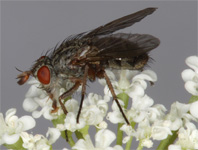Abstract
The small scaled rock agama, Paralaudakia microlepis, is an agamid lizard distributed across many parts of the Iranian Plateau. In the present paper, our aim is to study the genetic variability among different populations of this species in Iran. Based on the ND4 mitochondrial gene fragment, we uncovered high levels of genetic variability between three main clades of the species in Iran. Based on these results, the South Khorasan and Fars populations diverged firstly and then the Kerman and the Sistan-Baluchestan populations split. This pattern of divergence suggests an important role of the Zagros Mountain in the differentiation among populations of P. microlepis in Iran during the mid-Miocene. The Zagros uplift and subsequent aridification in the Iranian Plateau might have been involved in the variation among populations of this species because they are restricted to specific ecological niches. The greater genetic distances between the Fars and South Khorasan populations indicated that they have the potential to be described as different subspecies of P. microlepis. Comparison of all P. microlepis, P. erythrogastra and P. caucasia populations using both molecular and morphological characters is needed to make a strong taxonomic decision on the clade as a whole.
References
Ananjeva, N.B., Golynsky, E.A., Hosseinian Yousefkhani, S.S. & Masroor, R. (2014) Distribution and environmental suitability of the small scaled rock agama, Paralaudakia microlepis (Sauria: Agamidae) in the Iranian Plateau. Asian Herpetological Research, 5, 161–167.
https://doi.org/10.3724/SP.J.1245.2014.00161
Anderson, S.C. (1999) The lizards of Iran. Contributions to Herpetology, 15, 1–493.
Arèvalo, E., Davis, S.K. & Sites Jr., J.W. (1994) Mitochondrial DNA sequence divergence and phylogenetic relationships among eight chromosome races of the Sceloporus grammicus complex (Phrynosomatidae) in central Mexico. Systematic Biology, 43, 387–418.
https://doi.org/10.1093/sysbio/43.3.387
Baig, K.J., Wagner, P., Ananjeva, N.B. & Boehme, W. (2012) A morphology-based taxonomic revision of Laudakia Gray, 1845 (Squamata: Agamidae). Vertebrate Zoology, 62, 213–260.
Hlaing, T., Tun-Lin, W., Somboon, P., Socheat, D., Setha, T., Min, S. & Walton, C. (2009) Mitochondrial pseudogenes in the nuclear genome of Aedes aegypti mosquitoes: implications for past and future population genetic studies. Bmc Genetics, 10, 11.
https://doi.org/10.1186/1471-2156-10-11
Jackson, D.A., Peres-Neto, P.R. & Olden, J.D. (2001) What controls who is where in freshwater fish communities the roles of biotic, abiotic, and spatial factors. Canadian Journal of Fisheries and Aquatic Sciences, 58, 157–170.
Kabir, S., Shahriar, M., Kabir, A.H. & Uddin, M.G. (2012) High salt SDS-based method for the direct extraction of genomic DNA from three different Gram-negative organisms. CDR Journal, 1, 1–64.
Macey, J.R., Schulte, J.A., Ananjeva, N.B., Larson, A., Rastegar-Pouyani, N., Shammakov, S.M. & Papenfuss, T.J. (1998) Phylogenetic Relationships among Agamid Lizards of the Laudakia caucasia Species Group: Testing Hypotheses of Biogeographic Fragmentation and an Area Cladogram for the Iranian Plateau. Molecular Phylogenetics and Evolution, 10, 118–131.
https://doi.org/10.1006/mpev.1997.0478
Macey, J.R., Schulte, J.A., Larson, A., Ananjeva, N.B., Wang, Y., Pethiyagoda, R. & Papenfuss, T.J. (2000) Evaluating trans-Tethys migration: an example using acrodont lizard phylogenetics. Systematic Biology, 49, 233–256.
https://doi.org/10.1093/sysbio/49.2.233
Posada, D. & Crandall, K.A. (1998) Modeltest: testing the model of DNA substitution. Bioinformatics, 14, 817–818.
https://doi.org/10.1093/bioinformatics/14.9.817
Ronquist, F., Teslenko, M., Van Der Mark, P., Ayres, D. L., Darling, A., Höhna, S. & Huelsenbeck, J.P. (2012) MrBayes 3.2: efficient Bayesian phylogenetic inference and model choice across a large model space. Systematic Biology, 61, 539–542.
https://doi.org/10.1093/sysbio/sys029
Sanchooli, N., Rahimian, H., Rastegar-Pouyani, N. & Rastegar-Pouyani, E. (2015) Genetic and Morphological Variations within Laudakia microlepis (Blanford, 1874) (Sauria: Agamidae) Populations in Southeastern Iran with Description of a New Subspecies. Asian Herpetological Research, 6, 199–205.
Šmíd, J., Moravec, J., Kodym, P., Kratochvíl, L., Hosseinian Yousefkhani, S.S., Rastegar-Pouyani, E. & Frynta, D. (2014) Annotated checklist and distribution of the lizards of Iran. Zootaxa, 3855 (1), 1–97.
https://doi.org/10.11646/zootaxa.3855.1.1
Stamatakis, A. (2006) RAxML-VI-HPC: maximum likelihood-based phylogenetic analyses with thousands of taxa and mixed models. Bioinformatics, 22, 2688–2690.
https://doi.org/10.1093/bioinformatics/btl446

